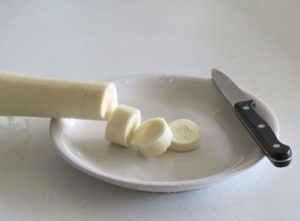
For people on a low-carb diet, pasta is often a banned or use-very-seldom food. Over the years, low carb and Keto practitioners have found several substitutes for the popular starch. What is Italian food without it? Asian food also uses a starch noodle, frequently made from rice, but also flour, in many of their dishes.
So, we’ve turned to cauliflower to substitute for macaroni, rice, and potatoes in our meals. It does an admirable job most of the time. Likewise, spaghetti squash, zucchini, and butternut squash have helped fill the void when you don’t eat pasta. Some companies are even developing low carb pasta from carb-reduced flour. More on those another time.
When I first saw an ad for Natural Heaven’s Hearts of Palm pasta, I did a double-take. But I ordered three varieties to try. The hearts of palm spaghetti comes in a sealed package, ready-to-use. Each package provides two-and-a-half servings. I always wonder about that odd packaging, but I’m guessing the producers look more at weight than servings when they package. For the record, this is 9 oz. of pasta. Each serving is 1/2 cup. The key nutrition values per serving are: calories=25, sodium=19mg, carbohydrates=4g, dietary fiber=2g, and protein=1g. The net carbs per serving=2g. That’s a great number!

These palms are harvested and prepared in Ecuador in a sustainable manner. They insure three stems grow replacing each one cut. The core of the palm stem is the heart, which can be cut, cooked, and eaten.
Hearts of Palm Spaghetti with Meatballs
Now to the taste test. I made a quick throw-together spaghetti using 1/2 cup of premade pasta sauce and premade mozzarella-sausage meatballs from the grocery. I pan cooked and slightly over-browned the meatballs, then broke them into smaller pieces. I added the pasta sauce and a little water and cooked the meatballs for about five minutes in the sauce.
Then I opened the pasta and slid it into the pan, carefully separating the strands with a spoon, so I didn’t break too many. The pasta is moist but doesn’t need to be drained before using.
Following the directions on the container, I turned my stove’s heat to medium and let it cook another four minutes, often stirring, to heat the pasta. Following my tradition, I sampled one noodle. It tasted similar to a regular strand, and the texture is like al dente pasta.
Once I served the dish, I added Parmesan cheese on top and a side salad and had a very tasty meal served on my fancy paper plates. It is very much like regular spaghetti with the sauce and cheese since most of the flavor comes from the sauce ingredients.
Bottom line, it’s a very good substitute for spaghetti in texture, color, and taste. Be adventurous and try it with your favorite spaghetti ingredients.
Cost-wise, at $4.99 a package through Netrition.com, it’s not too expensive. But given that it’s only 2-1/2 servings, it’s certainly higher than a spaghetti squash or a couple of zucchinis. Still, when you want a more authentic looking and tasting pasta, it’s worth it.

